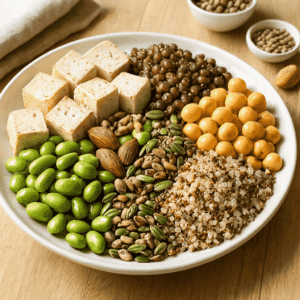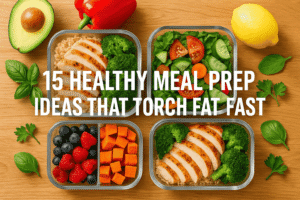Losing weight can feel like an endless challenge, but The Science Behind HIIT: Why It’s So Effective for Weight Loss offers a breakthrough solution. High-Intensity Interval Training (HIIT) is a powerful exercise method that alternates between intense bursts of activity and short recovery periods. This unique approach maximizes calorie burn, boosts your metabolism, and continues to torch fat even after your workout is done. Backed by cutting-edge research, HIIT has proven to be one of the most effective and time-efficient strategies for weight loss, making it a favorite for fitness enthusiasts worldwide.
When it comes to shedding pounds and boosting health, many of us have one burning question: “What’s the most effective way to lose weight without spending endless hours in the gym?” The answer lies in three powerful letters: HIIT (High-Intensity Interval Training).
HIIT workouts have taken the health and fitness world by storm, and for good reason. Backed by science, these short, intense bursts of exercise can transform your body, torch fat, and keep your metabolism revving long after you’ve stopped sweating. Let’s dive deep into why HIIT is your secret weapon for weight loss.
What Is HIIT? A Quick Overview
At its core, HIIT involves alternating between short bursts of intense exercise and brief recovery periods. For example, a 30-second sprint followed by 1 minute of walking, repeated for 15–20 minutes. The magic of HIIT lies in its intensity—you’re pushing your body to its limits during those high-energy intervals.
Unlike steady-state cardio, such as jogging, HIIT works on a principle called excess post-exercise oxygen consumption (EPOC), which keeps your metabolism elevated even after your workout is over.
Why HIIT Is So Effective for Weight Loss
1. Burns More Calories in Less Time
Who has hours to spend at the gym? HIIT is perfect for busy schedules, as it helps you burn a ton of calories in as little as 15–30 minutes. Studies show that a 20-minute HIIT session can burn as many calories as a 60-minute jog.
2. Increases Your Resting Metabolic Rate
Here’s where the magic happens: after a HIIT workout, your body continues to burn calories for up to 48 hours. This is due to EPOC, which requires extra energy to repair your muscles, restore oxygen levels, and regulate body temperature.
3. Targets Stubborn Fat
HIIT is particularly effective at targeting visceral fat—the deep belly fat associated with health risks like diabetes and heart disease. Research shows that HIIT can reduce body fat more significantly than moderate-intensity exercises.
4. Preserves Muscle Mass
Unlike traditional cardio, which can lead to muscle loss if overdone, HIIT helps maintain and even build lean muscle. More muscle means a higher resting metabolic rate, allowing you to burn more calories even when you’re not working out.
5. Improves Insulin Sensitivity
HIIT can enhance insulin sensitivity, meaning your body can process carbohydrates more effectively. This helps prevent fat storage and improves overall health, making it a game-changer for weight loss.
The Science Behind HIIT’s Effectiveness
1. Hormonal Boost
HIIT triggers the release of fat-burning hormones like epinephrine and norepinephrine, which signal your body to break down stored fat for energy. At the same time, it suppresses insulin levels, creating the perfect environment for fat loss.
2. Mitochondrial Efficiency
HIIT increases the efficiency and number of your mitochondria—the powerhouses of your cells. More mitochondria mean your body can burn energy (and fat) more efficiently, even at rest.
3. Cardiovascular Adaptations
Studies show that HIIT improves cardiovascular health by boosting your VO2 max (the maximum amount of oxygen your body can use). Better oxygen usage means better fat oxidation during and after exercise.
How to Get Started with HIIT Workouts
1. Choose Your Workout Style
- Bodyweight HIIT: Perfect for beginners. Try jumping jacks, burpees, and high knees.
- Cardio HIIT: Includes sprints or cycling.
- Strength-Based HIIT: Combines weights with intervals for maximum calorie burn and muscle growth.
2. Start Slow
Beginners should start with a 1:2 work-to-rest ratio (e.g., 20 seconds of effort, 40 seconds of rest). Gradually progress to a 1:1 ratio as you build endurance.
3. Consistency Over Intensity
While HIIT is effective, overdoing it can lead to burnout or injury. Aim for 2–3 sessions per week, balanced with other forms of exercise like strength training or yoga.
The Emotional Impact of HIIT Workouts
Beyond physical transformation, HIIT offers an incredible emotional boost. Imagine finishing a 30-minute session dripping with sweat, your heart racing, and a smile creeping across your face because you just conquered a tough workout. HIIT workouts can build confidence, reduce stress, and leave you with a sense of accomplishment like no other.
Feeling stuck on your weight-loss journey? HIIT can be the game-changer you’ve been looking for.
Success Stories: Real People, Real Results
Still skeptical? Meet Sarah from New York. She lost 25 pounds in three months by incorporating 3 weekly HIIT sessions into her routine. Or Daniel from Germany, who reduced his body fat percentage from 20% to 12% while improving his cardiovascular health. Their stories prove that with commitment and the right plan, HIIT works wonders.
FAQs About HIIT Workouts
1. How long should a HIIT workout last?
Most HIIT workouts last 15–30 minutes, making them ideal for busy lifestyles. The key is intensity—short and sharp beats long and slow.
2. Can beginners do HIIT?
Absolutely! Start with lower-intensity exercises and gradually increase your effort as you build fitness. Remember, progress takes time.
3. Do I need equipment for HIIT?
Not at all! Bodyweight exercises like squats, lunges, and burpees can deliver an effective HIIT workout. If you have access to equipment, such as a treadmill or weights, you can mix it up for variety.
4. Is HIIT better than steady-state cardio for weight loss?
Yes, HIIT is generally more effective for weight loss due to its calorie-torching intensity and post-exercise fat burn. However, steady-state cardio can still complement a balanced fitness routine.
5. Can HIIT help me build muscle?
Yes! Strength-based HIIT workouts combine resistance training and intervals, promoting fat loss and muscle growth simultaneously.
Conclusion
HIIT isn’t just another fitness trend—it’s a science-backed approach to weight loss that delivers results in less time. By challenging your body with short bursts of intensity, you’ll torch calories, shed fat, and transform your fitness level. Ready to make a change? Lace up your sneakers, set a timer, and let HIIT redefine your health and fitness journey.




